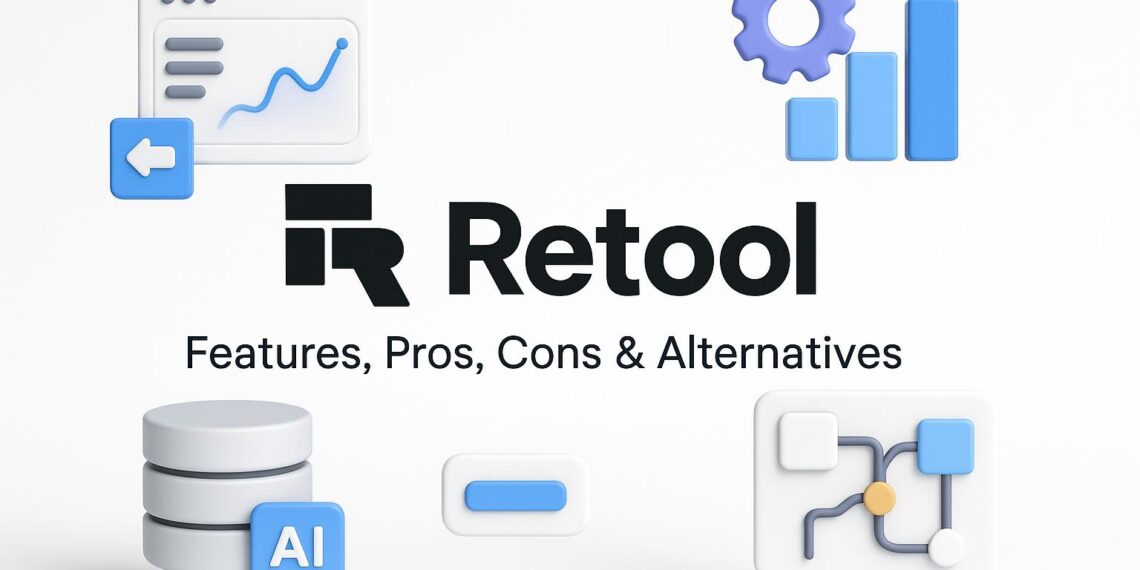Imagine you’re two months from demo day, and half your dev team is still glued to building admin panels and duct-taping together inventory dashboards. Every founder has been there—devs buried in internal tooling, while actual customers wait for updates. Internal tools are mission-critical but rarely “move the needle” for growth.🌟💹
Startups don’t struggle for ideas—they struggle for time. Most founders know the pain: hacking together admin dashboards, ops panels, or customer support tools just to keep the business running, all while core product work gets sidelined.🔥
That’s where Retool comes in. Billed as a “developer-first” low-code builder for internal software, Retool aims to turn your biggest operational headaches into polished apps in a fraction of the usual dev time. In this guide, we’ll unpack how it works, its must-know features, the real costs, where it shines (and doesn’t), and how it stacks up for early-stage teams eyeing scale.🎯
Overview
Born at YC in 2017, Retool was designed for teams where engineering bandwidth is gold but ops problems just keep multiplying. The core idea: let devs quickly assemble internal dashboards, admin panels, or custom workflows by dragging, dropping, and wiring up your databases and APIs—while also letting you write real JavaScript or SQL anytime you hit a wall. 💡
How does it fit in your stack? Picture this: Your product is powered by PostgreSQL and Stripe; your sales team begs for a single tool to check payments, update user accounts, and issue refunds. Retool connects to your data sources in minutes and lets you compose these “mashup” UIs, all with built-in role-based access and security. Whether you’re an early team of five or scaling at Series B, your ops wheels turn faster, so product engineering stays on track. ⚡️🧑💻
Key Features of Retool
Retool packs a serious punch for startups who need to move fast without hiring a massive ops team. These features are what turn Retool from a nice-to-have into a must-use if you’re juggling databases, APIs, and real-world business workflows.
Here’s what founders should REALLY care about (with a startup lens):
🔌 One-Minute Data Connections
Connect to PostgreSQL, MySQL, MongoDB, REST/GraphQL APIs, Google Sheets, Stripe, Salesforce & more—no weeks spent on auth/ORM boilerplate.
🛠️ Drag-and-Drop UI Builder with Real Code
Build slick dashboards or CRUD apps by dragging tables, forms, charts, lists, and buttons. For anything custom? Drop straight into JavaScript/SQL. No boxed-in “wizard” nonsense.
📊 Rich Component Library
Over 100 battle-tested widgets: sortable tables, Kanban boards, charts, user management panels, even barcode scanners. Designed for real data ops, built to save you (and your users) hours.
🔒 Granular Permissions & Audit Logs
Out-of-the box SSO, RBAC, team-based access, and detailed logs for when investors or compliance teams start asking tough questions.
⚡️ “Workflows” for Backend Automation
Need to automate a nightly sync, kick off webhook-driven tasks, or run multi-step business logic? Retool Workflows handles backend ops logic straight in the UI, no cron hacks or glue code required.
📱 Retool Mobile
Build native-like iOS/Android apps for warehouse teams, field ops, or distributed workforces. Code and publish from the same Retool account.
🧠 Retool AI Actions (New)
Integrate GPT or Claude models to automate inbox triage, summarize support tickets, or generate draft replies right in your tools—without bolting on yet another SaaS.
✨ Modules & Reusability
Package your “User Profile,” “Order Lookup,” or “Metrics Chart” as modules, then reuse across multiple internal tools for consistency and speed.

Retool Pros and Cons
Let’s get real for founders: here’s what makes—or breaks—Retool in actual startup life.
👍 Pros
- Blazing fast for MVPs and ops tools (think hours, not sprints)
- Lets devs use JavaScript/SQL (not boxed-in “no-code”)
- Huge library of integrations and components
- Centralizes internal apps and access control
- Handles hosting, updates, and security for you (cloud)
- Startup credits and generous free plan available
👎 Cons
- Per-user pricing can sneak up at scale (especially for >20 users)
- Complex apps can get hard to debug/maintain without discipline
- UI look/feel is “internal tool chic”—pixel-perfect branding is tough
- Non-devs hit walls on anything past simple drag-and-drop
- Vendor lock-in (migrating away later will require real effort)
Considering Retool for Startups
Choosing a platform like Retool should depend on your stage, stack, and roadmap. Here’s a checklist for founders to stress-test the fit:
📊 How painful are your current internal tools?
Are workflows stuck in Google Sheets and Zapier hacks? Retool shines for consolidating messy ops.
💰 What’s your budget and team size today—and 12 months out?
The free plan is generous, but costs climb if lots of users need access or you’re supporting entire ops/sales teams.
🧑💻 Do you have any devs or technical builders available?
You need at least one JavaScript/SQL-savvy dev to truly unlock Retool’s speed and flexibility.
🔗 How many different data sources or APIs do you depend on?
If you need to mash up data from Stripe, postgres, Airtable, or internal APIs, fast integration is a win.
🚀 Do your internal tool needs change monthly?
If ops are rapidly evolving, Retool’s rapid iteration lets you adapt tools in hours, not backlogs.
🔒 Does security, permissioning, or audit logging matter (yet)?
If you’re in fintech, healthcare, or handling sensitive data, granular access and logs are a must—Retool delivers out-the-box, but some of these features are gated to higher plans.
📲 Do you need mobile-ready ops tools?
Retool Mobile lets you build internal apps for field teams with the same logic/components.
🧠 Will you experiment with AI-internal automation?
If you want to layer LLMs into support, lead gen, or workflows, Retool’s AI integrations accelerate MVPs.
Retool Plans and Pricing
| Plan | Monthly Price (Annually Billed) | Usage Limit | Key Features |
|---|---|---|---|
| Free | $0 | 5 Standard Users | Unlimited apps, core connectors, cloud hosting |
| Team | $10/user (Std), $5/user (End) | Unlimited apps & users | User groups, releases, prod/staging, faster queries |
| Business | $50/user (Std), $15/user (End) | Higher limits | RBAC, Git versioning, modules, audit logs, custom branding |
| Enterprise | Custom | Varies | Self-hosting, SAML/SSO, advanced compliance, support |
Notes:
- “Standard Users” build/edit apps; “End Users” just use apps (can edit data, not app structure).
- Affordable at small scale, but be aware: add-ons (Mobile, Workflows, AI) = extra $ as you grow.
- Free plan only allows 5 builder users (enough for early-stage founders/tech leads!).
Retool Startup Discount or Promo Info
🎉 Retool for Startups: Up to $25,000 in credits!
If you’re pre-Series A (usually <2 years old) and/or part of major accelerators (YC, Techstars, etc.), you could get up to $25k in usage credits—effective for nearly a year or more of top-tier use.
💡 Even without promo, the free plan’s limits are unusually generous for early founder teams.
Other deals: Annual payments discount 20%. Check your accelerator or VC’s perks page for exclusive offers!
Comparing Retool with Alternatives
How does Retool stack up against popular startup alternatives like Appsmith (open source) and Budibase? Here’s the breakdown:
| 🧩 Feature | Retool | Appsmith | Budibase |
|---|---|---|---|
| 🏱 Free tier | Yes (5 builders, unlimited apps) | Yes (unlimited users, open source) | Yes (cloud plan & open source) |
| 🧠 Developer focus | Dev-centric, full JS/SQL in UI | Dev focus, strong open-source | Slightly more accessible for non-devs |
| 🔌 Native integrations | 40+ DBs & SaaS APIs | 20+ DB/APIs, custom plugin support | 10+ DBs/APIs, built-in database |
| 💸 Pricing simplicity | Per builder & per end user | Per builder; end users often free | Per builder/app user ($4–$8/mo) |
| 😹 Open source | No (self-hosting is paid) | Yes (Apache 2.0, free hosting) | Yes (MIT License, free hosting) |
| 📱 Mobile tools | Native mobile builder (Retool Mobile) | Beta (limited mobile) | No direct mobile support yet |
| 🧠 AI actions | LLM/AI workflow integrations | Some AI features via plugins | Limited/no native AI integr. |
| 🎯 Best for | Fast, complex ops tools w/ real code | Startups wanting OSS/self-hosted | Semi-tech teams, simple tools |

Bottom line for founders:
- Retool = fastest for rich, multi-source internal tools, but cost rises at scale.
- Appsmith = best open source value, strong for dev teams who want control and cost savings.
- Budibase = great for form-heavy CRUD apps and flexible hosting (self-host, cloud).
FAQs
❓ Is Retool beginner-friendly?
Setup is fast—real MVPs in hours—but meaningful use (complex tools, custom logic) needs JavaScript/SQL skills.
❓ What are the hidden costs?
End-user seats, add-on products (Workflows, Mobile, AI), and “Enterprise” self-hosting can add up—model for scale.
❓ Can I use Retool for customer-facing apps?
It’s internal-tool first. External “portal” users are supported on higher plans, but at a premium.
❓ Do I need to be a developer?
Non-devs can use built apps. Building/maintaining anything custom: you need a dev, period.
❓ What about open source/self-hosting?
Retool’s enterprise self-hosting is paid only. If full OSS and no vendor lock-in are musts, look at Appsmith or Budibase.
❓ Will my data be safe?
Yes—RBAC, SSO, and SOC2/ISO compliance (cloud). Self-host for more control, but it’s pricier and you manage uptime.
❓ How does migration or “lock-in” work?
Moving grown-up tools off Retool is not trivial. Plan for some lock-in if you get deep.
❓ What support does Retool provide?
Community and docs on free, email on paid, with priority/dedicated support on high tiers.
Final Thoughts
Retool is the startup founder’s fast-forward button for getting internal ops out of Google Sheets hell and into real, reliable software—without torching your core product roadmap. MVP an admin dashboard or support CRM in a coffee-fueled afternoon. Iterate with speed. Free up your engineering firepower for user-facing work, not admin tasks. If you have even a single dev with JavaScript chops, the free plan or $25k in credits (if you qualify) will supercharge your back office.💵✅
💡 Where it really sings: messy, multi-source ops, fast-growing teams drowning in manual slack, and early-stage startups that need to move now. ⚠️ Where to watch out: scaling cost for bigger/broader teams, debugging complexity, or if your ops are dead simple/off-the-shelf.
Still not sure? Kick off your next ops tool on the free plan, test your real workflow needs, and only upgrade when you’re seeing clear ROI. Or—if you’re worried about cost/lock-in down the line—trial open source friends like Appsmith/Budibase first.
Either way, knowing your internal tooling isn’t what’s slowing down your startup is worth every cent—and every hour saved.🚀










